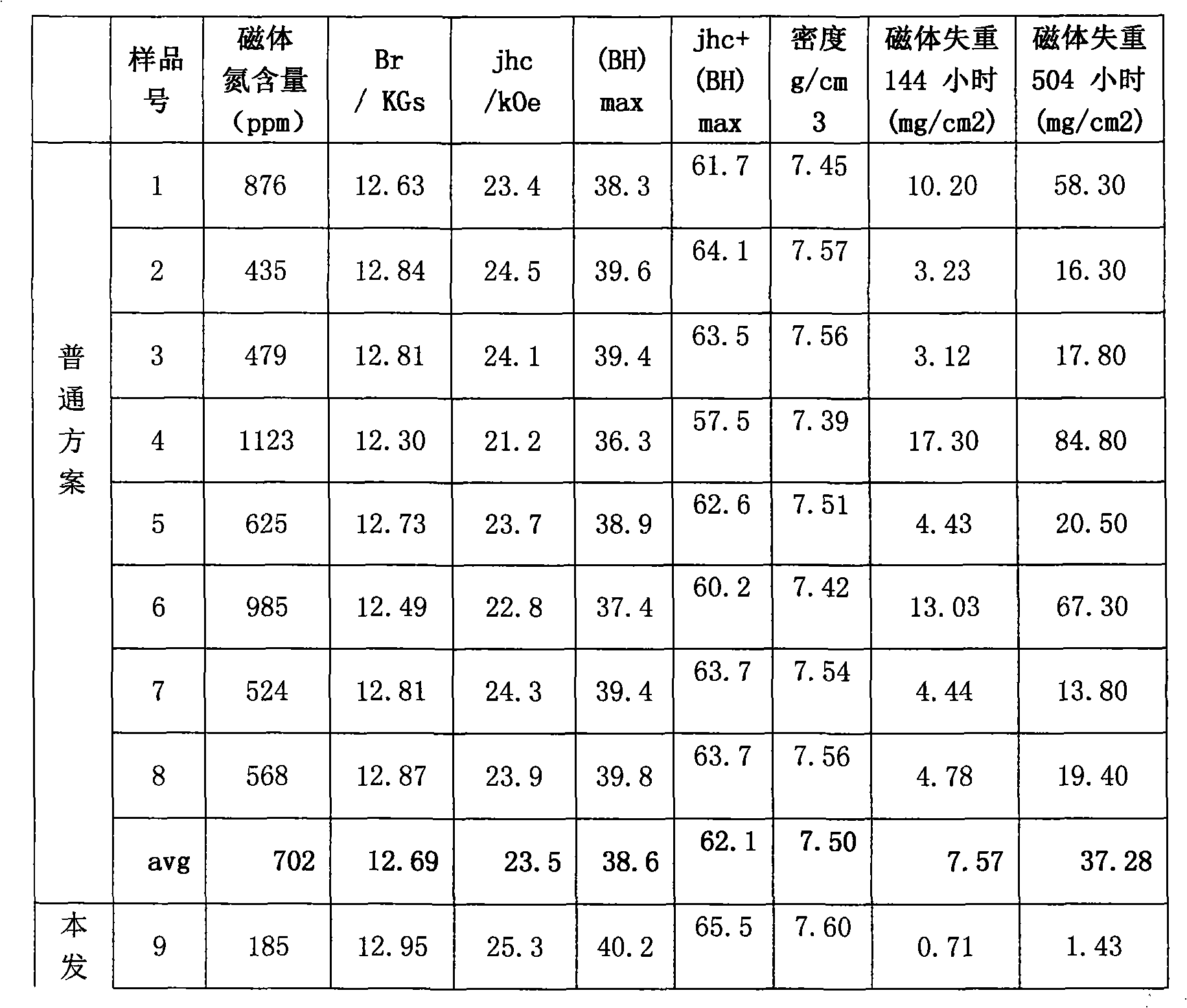Preparation method of trace nitrogen-containing Re-Fe-B permanent magnetic material
A permanent magnet material, trace technology, applied in the direction of magnetic materials, magnetic objects, electrical components, etc., can solve the problems of unspecified manufacturing methods, affecting the improvement of magnet performance and anti-corrosion performance, etc., to reduce the amount of magnets, corrosion resistance, etc. improved effect
- Summary
- Abstract
- Description
- Claims
- Application Information
AI Technical Summary
Problems solved by technology
Method used
Image
Examples
Embodiment 1
[0025] (1) Raw materials are made of various pure metals Nd, Pr, Dy, Al, Ga.Co, Fe and alloys B-Fe, Nb-Fe, etc. according to the design formula requirements;
[0026] (2) Various raw materials are formed into molten alloy by vacuum smelting, and then the molten alloy is cast and cooled on a quenched copper roller with a line speed of 1m / s, so that the molten steel forms a 0.3mm thick quick-setting thin strip;
[0027] (3) Hydrogen pulverization: Put the quick-setting thin strip into a rotary hydrogenation furnace, raise the temperature to 100°C and keep it warm for 30 minutes, fill it with an argon atmosphere with a partial pressure of 0.03 to absorb hydrogen, and the hydrogen absorption pressure is 0.1MPa. Use vacuum high temperature 480°C to dehydrogenate and fill with 0.01Mpa partial pressure argon every 30 minutes, and finally dehydrogenate to a vacuum degree below 0.5pa. After dehydrogenation, use reactor air cooling or water cooling to cool the hydrogenated powder to room...
Embodiment 2
[0034] Hydrogen pulverization in step (3): Put the quick-setting thin strip into a rotary hydrogenation furnace, raise the temperature to 200°C and keep it warm for 60 minutes, fill it with an argon atmosphere with a partial pressure of 0.05 to absorb hydrogen, and the hydrogen absorption pressure is 0.2MPa, When hydrogen is dehydrogenated, use vacuum high temperature 580°C to dehydrogenate and fill it with 0.05Mpa partial pressure argon every 30 minutes, and finally dehydrogenate to a vacuum degree below 0.5pa. After dehydrogenation, use reactor air cooling or water cooling to cool the hydrogenated powder At room temperature, keep the hydrogen content of the hydrogenated powder at 500ppm, so that the hydrogenated powder leaves a small amount of hydrogen and has a reducing atmosphere during sintering without the hydrogen content being too high, so that the Re-Fe-B powder can absorb nitrogen during the process;
[0035] Step (7) sintering, sintering the compact in a vacuum sinte...
Embodiment 3
[0038]Hydrogen pulverization in step (3): Put the quick-setting thin strip into a rotary hydrogenation furnace, raise the temperature to 150°C and keep it warm for 45 minutes, fill it with an argon atmosphere with a partial pressure of 0.04 to absorb hydrogen, the hydrogen absorption pressure is 0.15MPa, When hydrogen is dehydrogenated, use vacuum high temperature 500°C to dehydrogenate and fill it with 0.04Mpa partial pressure argon every 18 minutes, and finally dehydrogenate to a vacuum degree below 0.3pa. After dehydrogenation, use reactor air cooling or water cooling to cool the hydrogenated powder At room temperature, the hydrogen content of the hydrogenated powder is 550ppm, so that the hydrogenated powder leaves a small amount of hydrogen and has a reducing atmosphere during sintering without the hydrogen content being too high, so that the Re-Fe-B powder can absorb nitrogen during the process;
[0039] Step (7) sintering, sintering the compact in a vacuum sintering furn...
PUM
 Login to View More
Login to View More Abstract
Description
Claims
Application Information
 Login to View More
Login to View More - R&D
- Intellectual Property
- Life Sciences
- Materials
- Tech Scout
- Unparalleled Data Quality
- Higher Quality Content
- 60% Fewer Hallucinations
Browse by: Latest US Patents, China's latest patents, Technical Efficacy Thesaurus, Application Domain, Technology Topic, Popular Technical Reports.
© 2025 PatSnap. All rights reserved.Legal|Privacy policy|Modern Slavery Act Transparency Statement|Sitemap|About US| Contact US: help@patsnap.com


